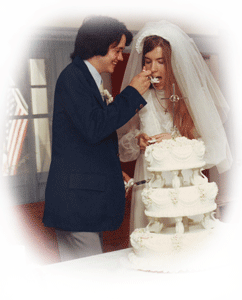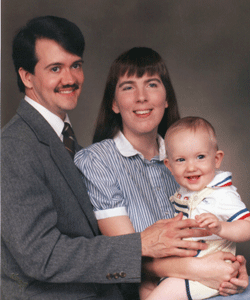Preschoolers think it is “all about me,” so why care about history? Your
little one will care very much about “his story”—the story of where he
or she came from, and by extension, family genealogy!
In order to comprehend genealogy, kids need to understand time concepts.
Look for opportunities to talk with your children about past, present,
future, yesterday, today, weeks, months, years, recently, long ago, real
and pretend. For instance, you could say, “Last week, we went to the
store and bought bread and milk. Tomorrow, we will need to go back to
the store. What will we need?”
Small children love hearing stories about themselves. Look at pictures
and family movies from your child’s babyhood and beyond. After your
youngster knows a little of his or her personal history, in your child’s
own words, make a History of Me book. Include details such as birthday,
place of birth, siblings, favorite toys, pets, and favorite colors. Your
child may enjoy drawing pictures to illustrate his or her very own birth
and babyhood story.
 Talk about parts of your personal history that are different, and other
things that are the same. For instance, perhaps you went to church as a
child, but you lived in a different state. You could share recollections
of how you and your spouse met, and about early jobs, education, and the
birth of siblings.
Talk about parts of your personal history that are different, and other
things that are the same. For instance, perhaps you went to church as a
child, but you lived in a different state. You could share recollections
of how you and your spouse met, and about early jobs, education, and the
birth of siblings.
Be ready to answer questions that may crop up, such as “Where did I come
from?” Usually, when a very young child asks this question, they are not
looking for a complicated answer involving biology or marital relations.
It is usually best to answer as simply as possible and elaborate if the
child asks more complex questions. If you wish, you could share a
child-friendly book, such as The Story of Me by Stan Jones and Brenna
Jones.
As your child learns family history, “it’s all about me” can shift into
a curiosity about and concern for others. Most little kids want to know
about the people they care about and extended family, both living and
past. Your child might enjoy playing reporter and interviewing parents,
grandparents, and family elders. In most cases, family patriarchs will
be flattered and honored to share experiences with the younger
generation. However, you may encounter an unusual reticence regarding
sharing war or other traumatic experiences. If so, you might want to use
this opportunity to train your child in respectfulness, kindness, and
understanding.
Older kids, even teens, usually enjoy getting involved in family history
investigation. Perhaps an older sibling will work together with your
preschooler in exploring and recording family history. If so, an older
sibling could help your child write and read a list of ten open-ended
questions to ask, such as:
- “Tell me about your school.”
- “What games did you play when you were little?”
- “What was different when you were a child—cars, phones, television,
radio, recipes, cooking, work, money, stamps?”
Choose interesting questions that can’t be answered with just a yes or
no. Open-ended questions will be more likely to encourage conversations
and stories. You could also ask about family, jobs, pets, favorite
songs, foods, clothing, cultural differences, geographical locations,
and homesteads. Perhaps relatives can show you family heirlooms such as
quilts, clothing, letters, and personal items. Inquire about ways to
label, care for, and preserve family mementos. Relatives who live in far
away place may consent to sharing details through letters or Internet
phone conversations, such as Skype.com.

|
|
The whole Morgan family!
|
Dig deep enough, and every family has a few skeletons in the closet. For
instance, one homeschool family interviewed relatives on tape, and got
an earful about family drinking, strictly for “medicinal purposes, of
course.” Ouch!
As parents, we can seek God’s wisdom to be honest, yet age-appropriate,
in our response to family issues. When we look to the Bible we can find
examples of family trouble, and share with our children how God offers
solutions in His word.
As your child grows, help him or her make sense of your family tree with
a genealogical chart. You can buy an ancestry chart to fill in together,
download a free chart from the Internet from sources such as
ancestry.com, or make your own. Help your child draw a large family tree
on poster board; record the oldest known relatives in your family at the
base of the tree and list family members on the branches, extending
upward through the generations. If you choose, and if you have enough
room on your chart, include photographs, dates, locations, marriages,
trades, and associations. If you’d like to find out more, search for
photographs and historical information from free public records such as
familysearch.org and the Library of Congress, catalog.loc.gov. Preview
information first; however, as you may encounter materials which you
feel are inappropriate.
Once your child has a good understanding of your family, begin to study
distant ancestors, countries and cultures. What cultures and languages
can you explore? For instance, our family tree includes ancestors from
England, Wales, France, Germany, and the Cherokee Nation. What did the
area where your ancestors lived look like ten years ago or one hundred
years ago? Study maps, both old and new. Through genealogical studies,
your child can learn real-world math, map skills, geography, foreign
languages, and history, all in a fun, natural way. For more about
uncovering and recording family history, visit “My History is American
History” savvyconsumer.org/help/misc/ my-history-p/my-hist.htm.
Holidays such as Memorial Day, Independence Day, Thanksgiving, and
Christmas bring memories close to mind and heart. How did our ancestors
celebrate holidays? Family vacations offer an opportunity to explore
family homesteads and historical sites. We can use birthdays to honor
our family patriarchs, as well as learn more about family history. We
can do more than simply send a card to our family member; we can
celebrate a life. If you wish, create a video history or birthday
scrapbook, and include the person’s life story and other mementos.
When we share family stories, pictures, and lore with our little ones,
we pass on a legacy and a dream—a dream that our children will live
lives that share God’s love with others in caring ways, learn from
mistakes and successes of the past, and make a difference in the world.
Melissa L. Morgan is the co-author of Educational Travel on a Shoestring
and Homeschooling on a Shoestring. With her husband, Hugh, she has
homeschooled their three children from birth, taking advantage of many
educational opportunities in the real world. She invites you to visit
her website at www.eaglesnesthome.com.